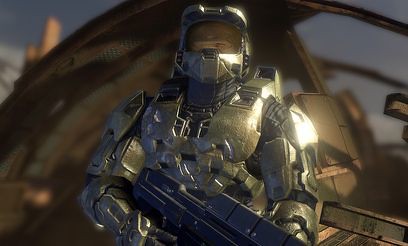
Last week it was announced that McFarland toys will be taking over the duties of producing the Halo action figures that was once done by Joyride.
Todd McFarland visited Bungie studios to get a "feel" for the Halo franchise and while in town he sat down for an interview.
In the wake of the McFarlane Toys and Bungie team-up to create a line of action figures for Halo 3, we chatted to Todd McFarlane, overlord of the eponymous McFarlane Toys empire about his recent trip to Bungie, some of what goes into making a good action figure and what lured McFarlane Toys to the Master Chief.
Q: You came to visit Bungie to get a feel for the game – what were your impressions?
Todd McFarlane: You know what, I’m an artist/CEO and I have to wear both of those hats from time to time. When I came back [from the visit] I was telling people “I’ve been in a lot of places, it was the coolest set up I’ve ever been in.” If I could make my office work like that, I would. I wish I could. It looked like a big hangar and you could see everything from the time you get in. From an artistic point of view, you could see that it is a big, giant collaborative effort. I described it as ‘walking into a NASA center.’ It looks like you guys are building a bunch of nuclear stuff and then you can see guys getting into trouble, throwing paper airplanes, and goofing around.
Q: What’s the most important thing about recreating a licensed character, such as the Master Chief?
TM: Really, the number one thing for recreating any license is the accuracy of it. If you’re not getting it right, then you’ve got to do a lot of things to compensate to get it right. It’s tough to get past that first hurdle.
From our understanding, the third game is trying to broaden the audience a little bit more, and be more than a mature shooter – that can become a bunch of old guys playing after awhile. Although we’ve done some sophisticated looking toys, the mindset is to make these as accessible and affordable as possible. It’s easy to do $25 items and trick ‘em out, but you’re playing to a bit of an older demographic. But when you target a more diverse group of consumers, you have to make them more accessible in a number of ways.
Q: These figures are 4-6” tall, these are a bit smaller than Halo fans were used to with our previous toymaker. How did you guys select the sizes for the figures?
TM: Here’s what ends up happening: You’ve got two mainstreams that you can distribute toys through: Mass outlets and for lack of a better word, non-mass. The non-mass is easy; we’ve got that one locked down pretty well.
Over the last six to seven years, some companies that would’ve taken a decent amount of Halo product have changed and amalgamated, and the strong business of doing higher-end, specialty stuff isn’t there. Your next option is to try and sell a couple of those items at mass [market], but you’ll take a loss. So we, as toymakers have to find a balance.
We’ll end up making a wide variety of sizes and prices, but out of the chute we need to make it appeal to a 12-year-old newbie and 25-year-old player alike.
Q: What aspects of the Halo characters and universe appeal to you most?
TM: For me, I’m a big fan of fantasy, sci-fi and monsters, having badasses going to shoot some bad guys is pretty fun. And then in Halo they’re not shooting zombies or other humans, they are shooting these cool, alien creatures. I don’t think it’s by accident that movies like Aliens and Predator do well; you guys have the Brutes, Grunts and the Flood. Your universe allows us as toymakers to do all of the things we’re good at.
Q: Can you describe a little of the actual process that takes the figure from start to completion?
TM: Let’s walk through Halo, specifically:
- We decide on whether to pick up the license.
- Then our lawyers work out the details (once you get past the lawyers you get to the fun part).
- We grab all of the assets that we can to try and get the accuracy as tight as possible. If we can get those size and shapes from you and you guys have done a terrific job of giving us color callouts and sizing, we’re just boring into that.
- Once we get that information down, we make a list of characters, weapons and vehicles that we think should hit the marketplace and those get approved.
- Then we start going and building our own wireframes.
- Those go into a computer and get kicked out into a wax form.
- The wax form is a “finished” product, before it gets painted up to whatever packaging we need to get around it. It’s usually twice the size of what people will be able to buy in stores.
- The models are shrunk down and mass produced, but at the factory it’s not unlike people buying model kits. At the factory themselves they wire they put all of the toys together and wire the toys into the packaging. Then it’s just a matter of shipping, distributing and displaying product at retail.
Thanks, Todd. Look for McFarlane Toys’ Halo 3 figures in 2008.






No comments:
Post a Comment